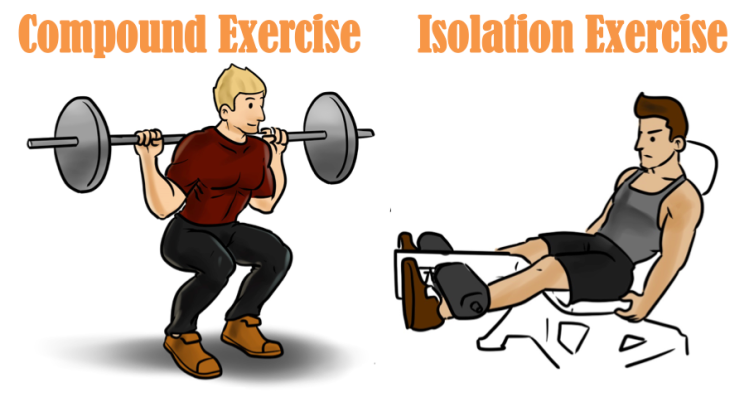
In the realm of resistance training, exercises can be broadly categorized into two types: compound exercises and isolation exercises. Both types of exercises have distinct benefits and play crucial roles in achieving strength, muscle growth, and overall fitness goals. Understanding the differences between compound and isolation exercises is essential for creating an effective workout routine that yields optimal training results.
Compound Exercises: The Foundation of Strength Training
Compound exercises are multi-joint movements that engage multiple muscle groups simultaneously. These exercises are considered the foundation of strength training and are essential for building overall strength and muscle mass. Examples of compound exercises include:
- Squats
- Deadlifts
- Bench Press
- Pull-ups
- Barbell Rows
- Lunges
- Leg Press
- Shoulder Press
Benefits of Compound Exercises
- Increased strength: Compound exercises work multiple muscle groups at once, allowing for heavier loads and increased overall strength.
- Efficient muscle growth: By engaging multiple muscle groups, compound exercises stimulate more muscle fibers, leading to greater muscle growth.
- Improved muscle coordination: Compound exercises require coordination and communication between multiple muscle groups, enhancing overall muscle function.
- Time-efficient: Compound exercises often work multiple muscle groups at once, reducing the overall number of exercises needed in a workout.
- Improved bone density: Compound exercises, such as squats and deadlifts, can help improve bone density, reducing the risk of osteoporosis and fractures.
- Enhanced athletic performance: Compound exercises can improve power, speed, and agility, making them essential for athletes and individuals looking to improve their overall athletic performance.
Isolation Exercises: Targeted Muscle Growth
Isolation exercises, on the other hand, are single-joint movements that target a specific muscle group. These exercises are designed to isolate and develop individual muscles, allowing for focused development and growth. Examples of isolation exercises include:
- Bicep Curls
- Tricep Extensions
- Leg Press
- Lateral Raises
- Chest Flys
- Shoulder Rotations
- Calf Raises
Benefits of Isolation Exercises
- Targeted muscle growth: Isolation exercises allow for focused development of specific muscle groups, making them ideal for targeting weak points or areas of concern.
- Improved muscle definition: By targeting individual muscle groups, isolation exercises can enhance muscle definition and visibility.
- Injury rehabilitation: Isolation exercises can be used to target specific muscles affected by injury or weakness, aiding in the rehabilitation process.
- Accessory work: Isolation exercises can be used as accessory work to complement compound exercises and enhance overall muscle development.
- Pre-habilitation: Isolation exercises can be used to strengthen specific muscles, reducing the risk of injury and improving overall muscle function.
Balancing Compound and Isolation Exercises
To achieve optimal training results, it’s essential to strike a balance between compound and isolation exercises. A well-structured workout routine should include:
- Compound exercises as the foundation: Use compound exercises as the primary exercises in your workout routine, focusing on exercises that work multiple muscle groups at once.
- Isolation exercises as accessories: Use isolation exercises as accessory work to target specific muscle groups and enhance overall muscle development.
- Periodization: Periodize your workout routine to vary the intensity, volume, and frequency of compound and isolation exercises.
- Progressive overload: Gradually increase the weight or resistance used in compound exercises to continue challenging the muscles and promoting growth.
Creating a Balanced Workout Routine
To create a balanced workout routine, consider the following:
- Start with compound exercises: Begin your workout with compound exercises, such as squats, deadlifts, and bench press.
- Add isolation exercises: Include isolation exercises, such as bicep curls and tricep extensions, to target specific muscle groups.
- Incorporate variety: Include a variety of exercises in your workout routine to target different muscle groups and prevent plateaus.
- Consider your goals: Tailor your workout routine to your specific goals, whether it’s building strength, increasing muscle mass, or improving overall fitness.
Conclusion
In conclusion, both compound and isolation exercises play crucial roles in achieving strength, muscle growth, and overall fitness goals. By understanding the benefits of each and striking a balance between the two, you can create a well-structured workout routine that yields optimal training results. Remember to prioritize compound exercises, use isolation exercises as accessories, and periodize your workout routine to achieve continued progress and growth.
